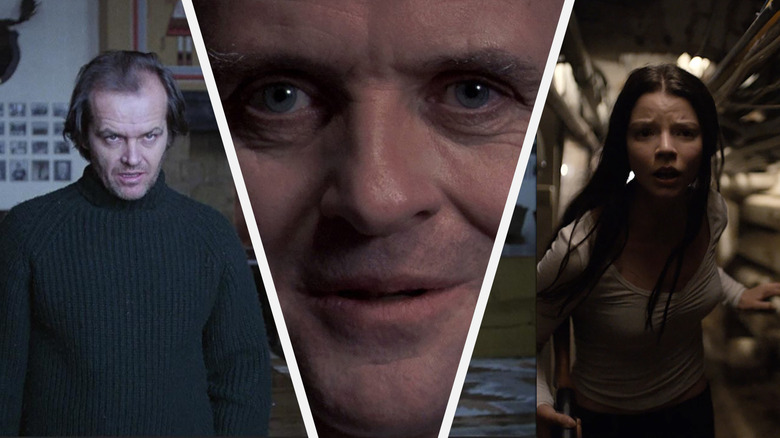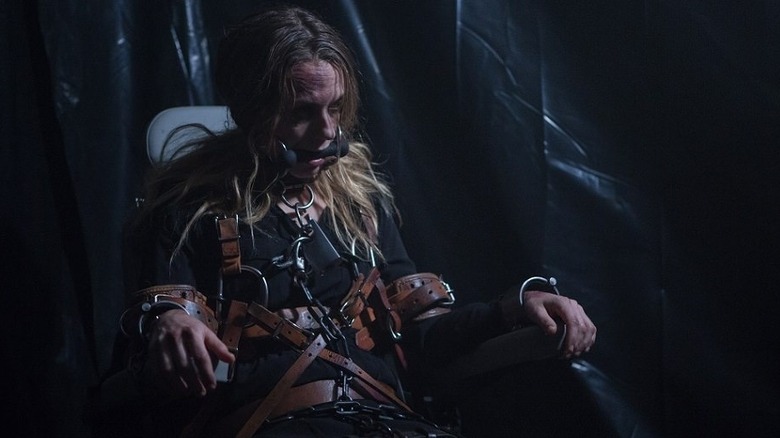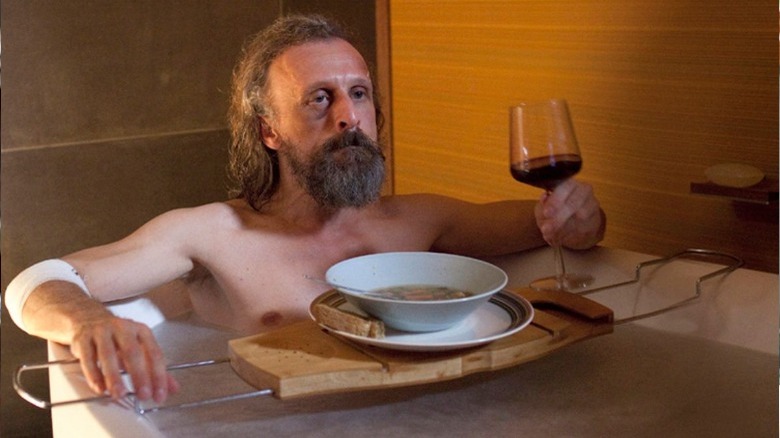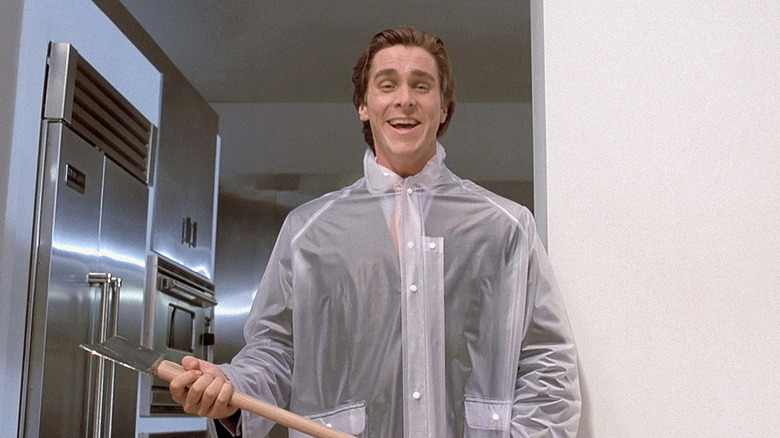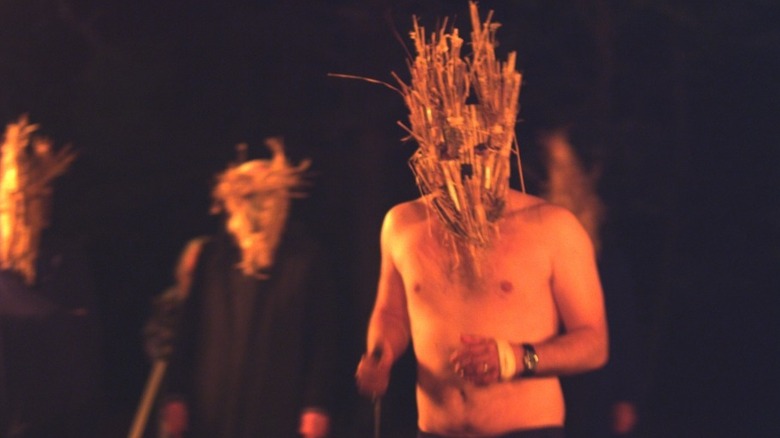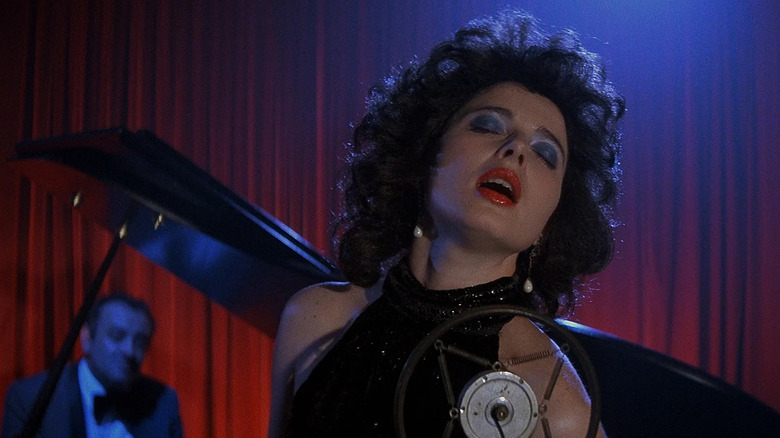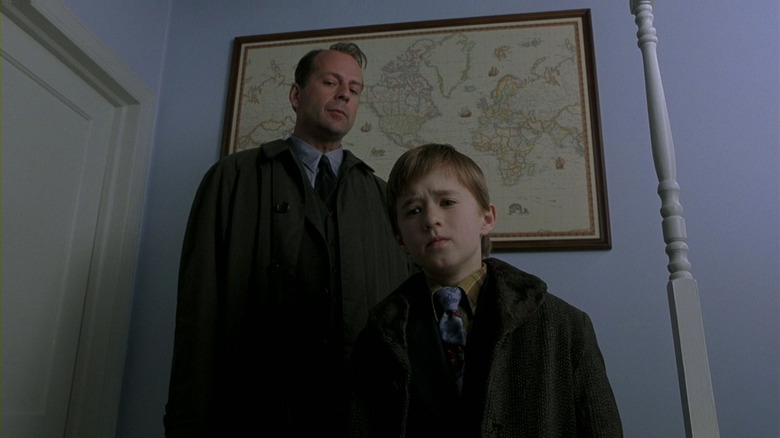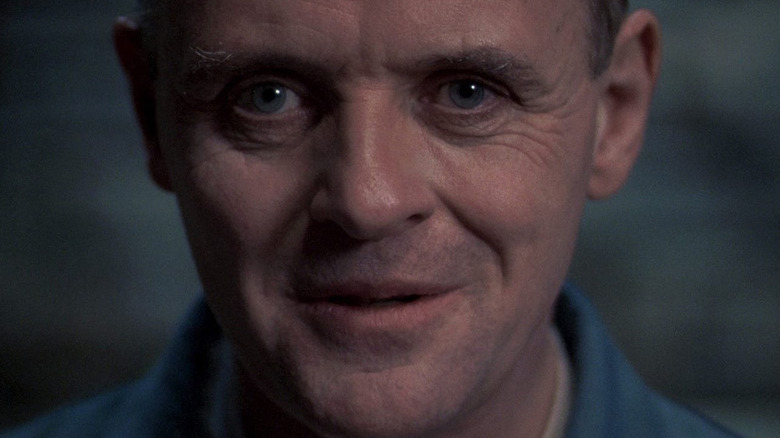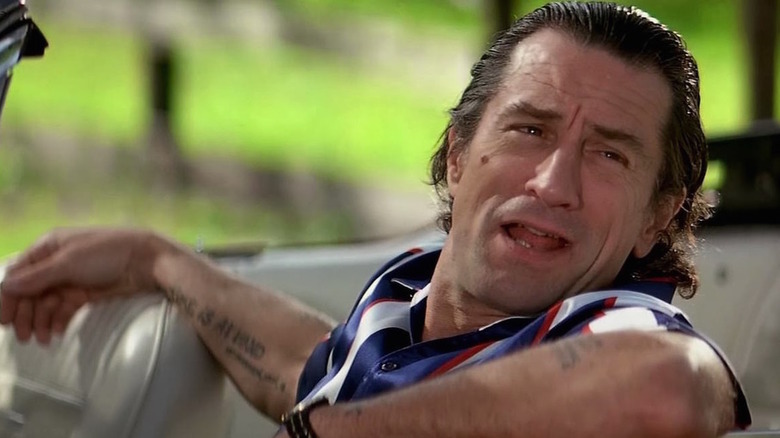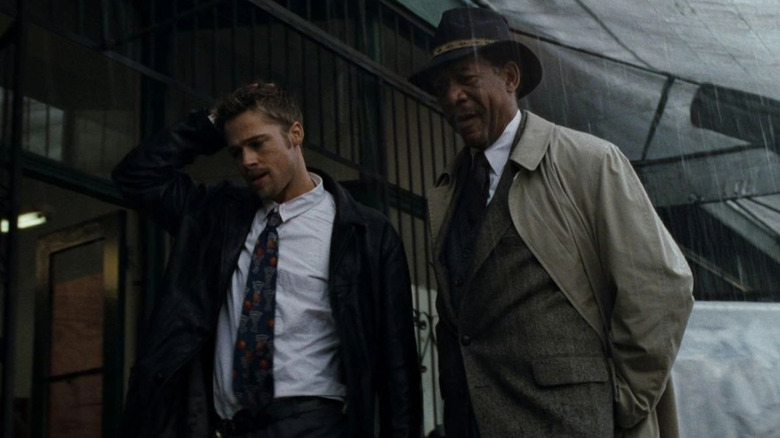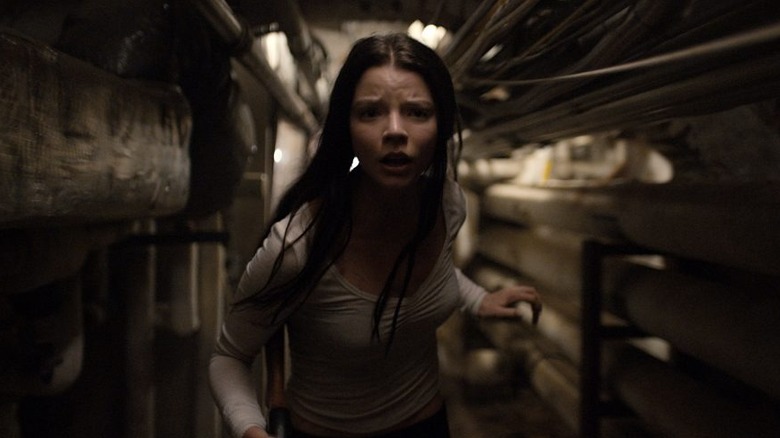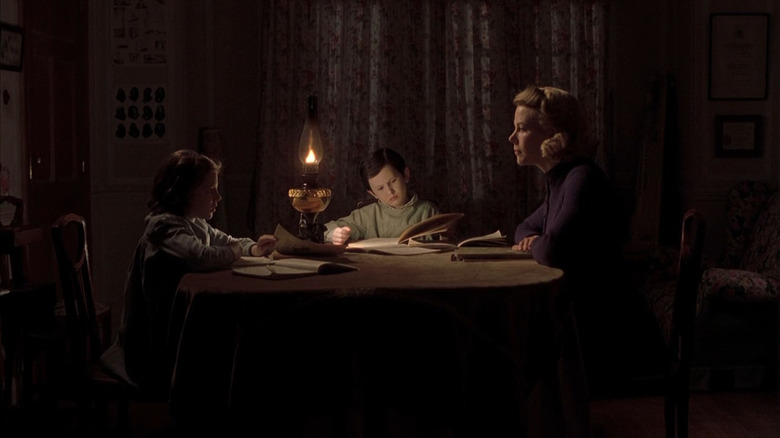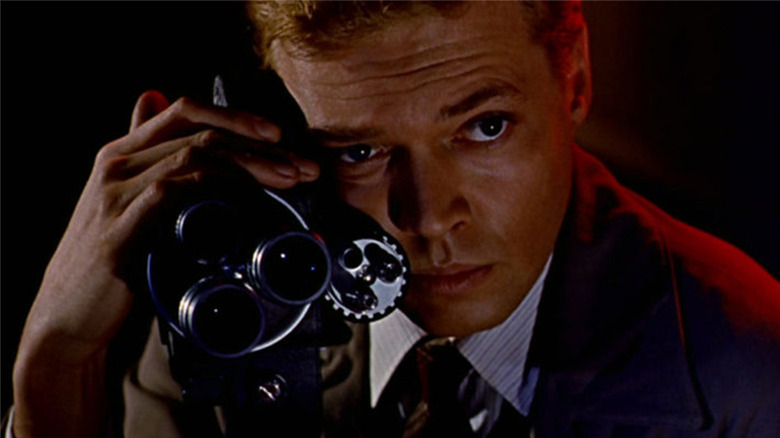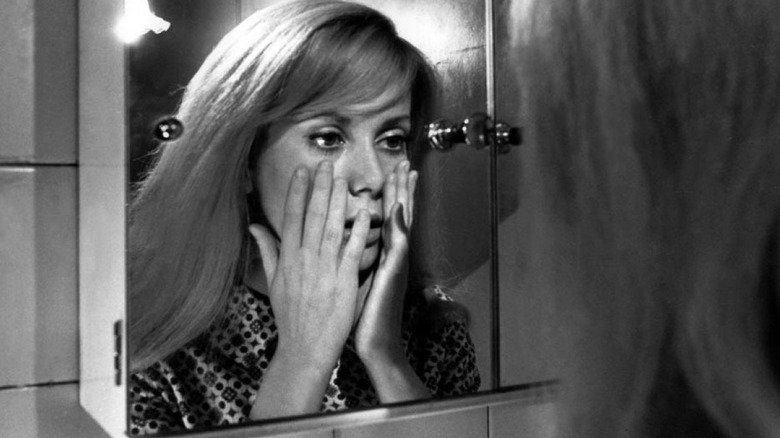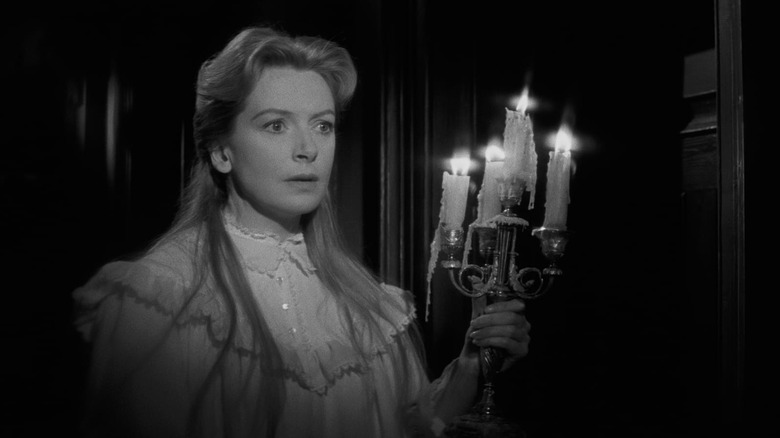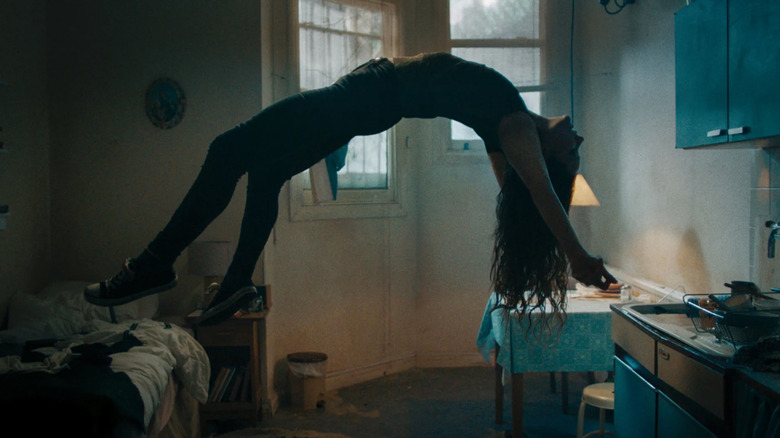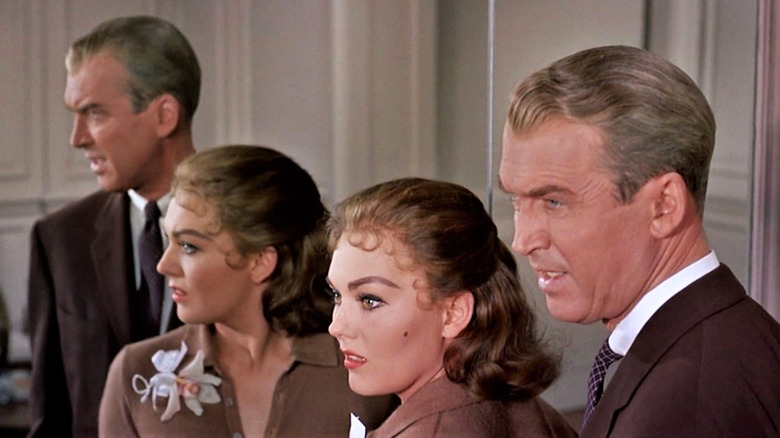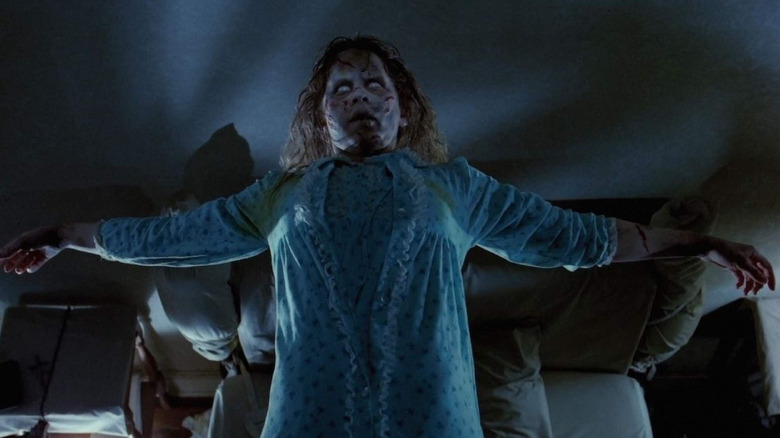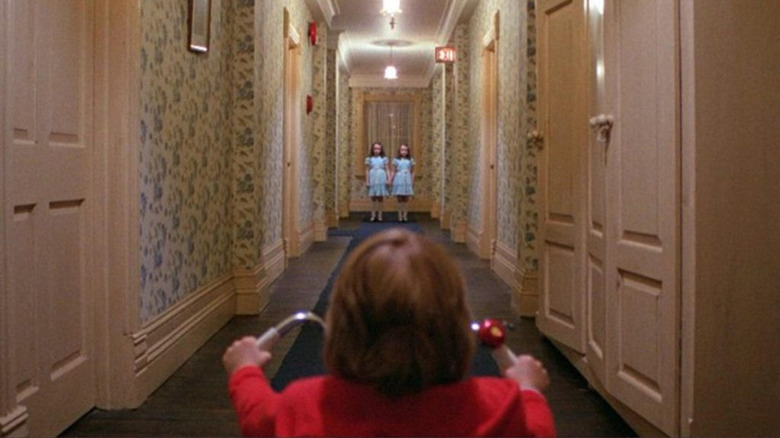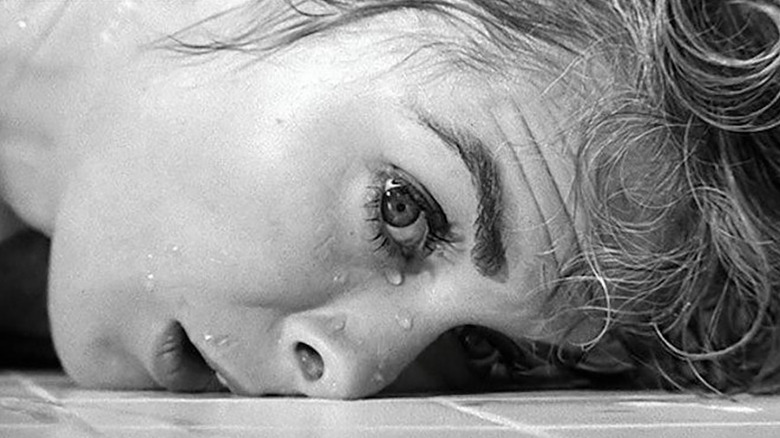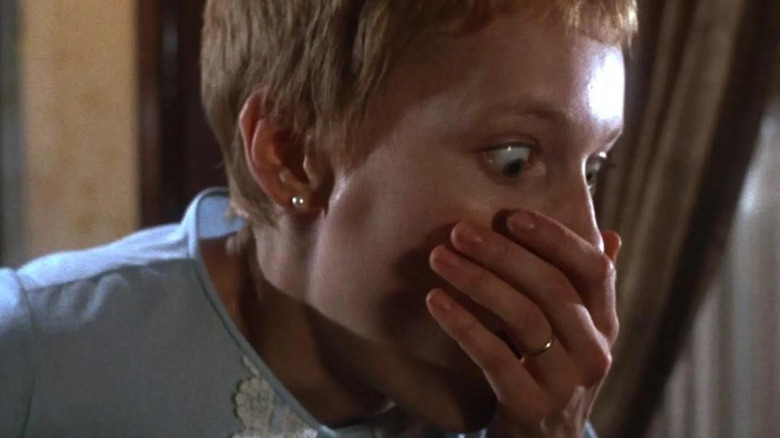The 20 Best Psychological Horror Movies Ranked
Horror films allow us to examine universal fears such as death, disease, or war in a relatively safe environment where we can shift the blame to definable external evils beyond our control. But psychological horror is different.
A popular horror sub-genre, psychological horror focuses on the darker aspects of the human psyche. Referred to by Jung as characteristics of the shadow archetype, these primal fears manifest as insanity, suspicion, distrust, self-doubt, and especially paranoia, and lead to unspeakable savagery if left unchecked.
Many great directors hold that true horror comes not from blood and gore but from what the viewer doesn't know, relying on the anticipation of a threat to create fear. Iconic cinematic moments such as the shower scene in "Psycho" are terrifying in part because the imagination is allowed — and even expected — to fill in the blanks. As the following psychological horror films show, the fantasies that unfold in our minds can be even more horrifying than reality.
20. The Bad Samaritan
Director Dean Devlin again collaborates with screenwriter Brandon Boyce for this film about an amateur Portland photographer, Sean Falco (Robert Sheehan), who works as a valet at a trendy Italian restaurant with his best friend, Derek Sandoval (Carlito Olivero). The job, of course, is a front; using the GPS on their clients' cars to find their empty houses, the two use the electronic garage door openers in the vehicles to commit robberies while the unsuspecting victims are enjoying their dinners.
One day, a millionaire narcissist named Cale Erendreich (David Tennant) arrives at the restaurant driving a Maserati. Sean takes it and heads to Erendreich's house as Derek watches Cale, only to find a woman (Kerry Condon) tied up inside. Sean contacts the police, but no attempt at a good deed goes unpunished — Cale uncovers Sean's identity using commonplace technology, and starts to wreak murderous havoc in order to ruin Sean's life.
The film's characters are subtly sophisticated as they wrestle with moral dilemmas. Classically trained Scottish actor David Tennant's performance is particularly disconcerting. Cale is presented as both someone to emulate — he is a successful businessman — and to despise, creating a fascinating dichotomy. While it wasn't a mega-blockbuster, the strong filmmaking behind "The Bad Samaritan" ensures that the film remains compelling over the entirety of its one-hour, 50-minute intellectual assault.
19. Borgman
Dutch writer and director Alex van Warmerdam received critical and international recognition for his 2013 film "Borgman," a mystifying descent into the macabre that racked up awards nominations overseas. In it, the leader of a criminal group, a vagrant named Camiel Borgman (Jan Bijvoet), insinuates himself into an affluent family's country home. Then, he slowly pulls back the curtain on their seemingly perfect lives as revenge for being shunned.
"Borgman" is a whimsical film that delivers terror in masterstrokes. It's a complex character study that addresses the eradication of the traditional family unit, and that demonstrates how abuse leads to betrayal. The characters show remarkable range in their behavior, while the film creates an unshakable feeling of apprehension through dark comedic scenes that contrast with moments of unspeakable violence. Camiel's maliciousness is notably causal, sometimes feeling almost like an afterthought — and thereby making the horror that much more menacing.
The dissonant chords of the diatonic score create a tense, off-kilter atmosphere that contributes to the film's insidious quality. Whether watched during the day or late at night, this is one that's bound to linger.
18. American Psycho
In 2000, writer Guinevere Turner and director Mary Harron brought Bret Easton Ellis' incendiary best-selling novel to the big screen. It had been a long time getting there. For years, development on the project was plagued by creative disagreements and departing cast members. Later, after Lion's Gate gave the film a green light and a $10 million budget, the MPAA gave the film the kiss of death: an NC-17 classification, which forced Harron to make some cuts to secure the more commercially acceptable R rating.
The story involves a wealthy, narcissistic New York City investment banking executive, Patrick Bateman (Christian Bale), who is driven by ego and greed — and an urge to kill. As he delves deeper into the "male executive lifestyle" with the devotion of a fetishist, it becomes harder and harder to hide his psychopathic alter-ego from those around him.
"American Psycho" is a pitch-black satire of American morals, a dark and violent movie whose brutality elicits horror. A crucial aspect of the movie's success is Christian Bale's performance, with his dead-on, straight man approach to the role giving "American Psycho" much of its heft.
17. Kill List
In "Kill List," British indie director and screenwriter Ben Wheatley offers up a strange world that combines brutal urban familiarity with satanic terror. Simple in nature, the film follows failed contract killer Jay (Neil Maskell), who is desperate to find work to support his wife, Shel (MyAnna Buring), their young son, and Jay's best pal Gal (Michael Smiley). And so, Jay and Gal accept an assignment that slowly draws them into a world of horror. The people they confront are evil, but instead of counteracting these demonic forces, Jay finds himself increasingly attracted to them.
"Kill List" is a disjointed nightmare that chronicles Jay's descent into uncontrolled madness. There is a visceral rawness to "Kill List" that mirrors real life. Part of the horror stems from the brutal, incoherent violence and the lack of justification for its necessity. Our confusion feeds a growing inner disquiet, and an unsettling musical score enhances the ever-increasing sense of paranoia. Here, tea kettles don't whistle. They scream.
16. Blue Velvet
"Blue Velvet" is an insidiously mesmerizing masterpiece that could only come from the mind of writer-director David Lynch. Its story follows the discovery of a severed human ear found in a field just outside of a small American town, a find that spurs Jeffrey Beaumont (Kyle MacLachlan), a college student home to visit his ailing father for the summer, into action. Jeffrey's investigations into the ear's origins lead him to nightclub singer Dorothy Vallens' (Isabella Rossellini) apartment, where he discovers that Dorothy is trapped in an abusive relationship with a psychopath named Frank Booth (Dennis Hopper), who has kidnapped her husband and son.
"Blue Velvet" is a beautiful film with complex characters and a hermetic script. Lynch's direction is at its apex here, drawing strong performances from MacLachlan, Hopper, and Rossellini. The surreal imagery is made even more so by a hauntingly hypnotic score, while the atmosphere of fear and suspense derives from seeing the mundane twisted by the terrifyingly sadistic.
15. The Sixth Sense
"The Sixth Sense," from writer and director M. Night Shyamalan, is an exceptional ghost film with one of the best reveals ever filmed. A frightened, withdrawn Philadelphia boy named Cole Sear (Haley Joel Osment) lives with his single mom, Lynn (Toni Collette). An outcast at school, young Cole ends up working with child psychologist Malcolm Crowe, to whom he reveals his big secret: In one of the most memorable lines in film history, the young boy declares, "I see dead people. They want me to do things for them."
The script for "The Sixth Sense" is unnerving, playing up the fear of an innocent child, and drawing terror from the things that most adults ignore. The soundscape is subtle, and the complexity of the storytelling makes it easy to suspend your disbelief and overlook crucial hints until Shyamalan hits you with that big twist.
"The Sixth Sense" makes good use of its $40 million budget, creating an unforgiving, somewhat terrifying afterlife with minimal special effects. The cast is strong, and the on-screen chemistry between the two leads deepens the film's believability.
14. The Silence of the Lambs
Ted Tally crafted Thomas Harris' bestselling novel "The Silence of the Lambs" into a strong screenplay, which served as the foundation for a film that won five Oscars and collected awards all over the world.
Trainee Clarice Starling (Jodie Foster) is recruited right out of Quantico by Jack Crawford (Scott Glenn), a member of the FBI's Behavioral Science Services Unit. He's investigating a serial killer known as Buffalo Bill, who skins his female victims, and wants to interview imprisoned killers for extra insights. However, Dr. Hannibal Lecter (Anthony Hopkins) refuses to cooperate; Crawford hopes that Starling may be able to get through to him.
As directed by Jonathan Demme, "The Silence of the Lambs" is brilliantly intense and brutal, making this the king of serial killer films. The cast is exceptional. Foster brings a determined naivete to the role that contrasts perfectly with the psychopathic villains' darkness, but it's Hopkins' Lecter who steals the movie. The actor creates a chillingly authentic character who imparts terror with a subtle smile. "The Silence of the Lambs" inspired a plethora of sub-genre psychological horror and thriller films and has more than stood the test of time.
13. Cape Fear
"Cape Fear" is a remake of a film from 1962, which was in turn based on a novel by John D. MacDonald. Expertly directed by Martin Scorsese, this film noir riff tells the story of a convicted rapist named Max Cady (Robert De Niro), who is released from prison after serving a 14-year sentence and begins stalking the family of his former lawyer, Sam Bowden (Nick Nolte). Gregory Peck also appears as Lee Heller, Cady's current legal representative, while Robert Mitchum plays Lieutenant Elgart; Mitchum, of course, played Cady in the original movie.
A graphically violent film, "Cape Fear" defines its characters not by their strengths, but by their weaknesses, emphasizing the theme of human frailty. As is Scorsese's strength, this is a film without any traditional heroes. Rather, a stratum of evil serves as the foundation for the typical Scorsese protagonists, men tortured by guilt and the weakness of the flesh who often seek forgiveness and redemption.
12. Se7en
Upon its initial release, David Fincher's "Se7en" picked up 43 award nominations, including a BAFTA and an Oscar nod. Written by Andrew Kevin Walker, this modern-day film noir is grim and disturbing.
"Se7en" follows two detectives, a rookie named Mills (Brad Pitt) and Somerset (Morgan Freeman), a veteran cop, as they hunt a serial killer known as John Doe (Kevin Spacey). A true psychopath, Doe twists the seven deadly sins of greed, lust, gluttony, pride, wrath, envy, and sloth into the basis for heinous murders.
The plot is straightforward, and Fincher's pace is deliberate and strategically unnerving. As a whole, the acting is solid. Spacey is brilliant as the villain, and several supporting cast members give equally strong performances. The soundscape is dark and unforgiving, and the dingy sets, haunting cinematography, and desolate landscapes add a moody depth to the film. When it was released, "Se7en" upped the ante for psychological horror; even now, it remains a huge influence on the thrillers that followed.
11. Split
"Split" follows three girls who have been kidnapped by Dennis (James McAvoy), a man who has 23 distinct personalities, most of which are highly dangerous. The girls must escape before a 24th appears.
From writer and director M. Night Shyamalan, this international award-winner showcases McAvoy's agility and precision. His portrayal of a troubled soul combines flashes of vulnerability, fragility, and dark humor, creating a seductive and suspenseful realism. Anya Taylor-Joy also gives an outstanding performance as Casey, the quiet tag-a-long whose quiet strength makes her a perfect foil for McAvoy's internal chaos. But the most frightening element is the interaction of Dennis' various personalities, and how they manipulate and intimidate each other.
Shyamalan's use of flashbacks to provide perspective on the lean narrative complements a film that's constantly in motion. Additionally, the production design and lighting, combined with West Dylan Thordson's haunting sound design, create an unsettling experience from start to finish.
10. The Others
It is 1945 in the Channel Islands. World War II has ended, and Grace Stewart (Nicole Kidman), a religious and over-protective mother, lives in a Victorian mansion with her two photosensitive children. She hires three servants, Bertha Mills (Fionnula Flanagan), Edmund Tuttle (Eric Sykes), and Lydia (Elaine Cassidy), to replace the previous staff members, who vanished earlier. That's when the ghosts start to appear.
"The Others" is a chilling haunted house story. The eerie musical score creates a languorous, dreamy atmosphere, and writer-director Alejandro Amenábar's deliberate pace and use of contrasting shadows deliver a dark, haunting tale that takes advantage of the mansion's period detail.
Nicole Kidman gives a strong performance that's more subtly dramatic than the hysterics that you'll find from most horror movie heroines. Flannagan perfectly embodies the archetype of the sinister housekeeper, and Alakina Mann is terrific as Anne, the stubborn daughter who keeps seeing dead people.
9. Peeping Tom
Writer Leo Marks' original story "Peeping Tom" is considered a true horror classic. In fact, it's often called the "British Psycho."
"Peeping Tom" is a psychological thriller told from the killer's point of view. It follows Tom (Bohm) as he murders women, using a movie camera to film their terrified final expressions. The movie puts its audience in the horrifying position of witnessing the murders as they learn more about Tom's childhood, forcing viewers to oscilate between sympathy for this tragic figure and horror at his psychopathic behavior. But the concept, not the film itself, is where the real horror lurks. Murder and voyeurism strike a chord deep within, reinforcing humanity's fascination with the macabre. The film's strong pace, close-ups on its actor's faces, and off-kilter camera angles build an unshakable sense of tension.
While Michael Powell made a beautifully-shot film about a camera following a camera to highly negative reviews. Upon release, "Peeping Tom" was universally hated by censors and critics, only to be resurrected a decade later by Martin Scorsese at a New York screening.
8. Repulsion
Roman Polanski's first English-language movie, "Repulsion," creates an environment of fear without special effects. This Berlin International Film Festival winner stars Catherine Deneuve, Ian Hendry, and John Fraser.
Polanski and Brach's story follows a sex-repulsed manicurist named Carol (Deneuve). Suffering from uncontrolled phobias, Carol disapproves of her sister's relationship with Michael (Hendry) and slowly descends into a deep depression, plagued by horrific visions of rape and violence.
The film is a terrifying study of paranoia and claustrophobic isolation, focusing on the complexity of the characters rather than the mechanics of the plot. Waiting until virtually the end of the film to introduce the glassy-eyed protagonist, Polanski creates a tense and terrorizing atmosphere that forces the audience to puzzle out the odd moments of dark comic relief — for example, a musical trio playing the banjo and spoons features a cameo from Polanski himself.
7. The Innocents
"The Innocents" received widespread critical acclaim for its psychological thrills and technological achievements. Based on Henry James' 1898 novella "The Turn of the Screw," the 1961 film is first and foremost a subtly developed Victorian England-era ghost story that follows a woman (Debra Kerr) who becomes the governess for a couple of extraordinary children. Discarded by their father (Peter Wyngarde), the kids have developed an almost unhealthy dependence upon each other. Jack Clayton directs this BAFTA nominee for best picture.
Kerr gives a consummate performance, and cinematographer Freddie Francis' focus on contrasting light with dark creates depth and a morbid Gothic feeling. By shooting the film in black and white, he also emphasizes the eeriness of the antiquated mansion. With its exquisite furnishings and static details, the house could easily be the star of the movie. It is a superbly terrifying and unforgettable film — one can understand why Martin Scorsese has listed it among the greatest horror films ever made.
6. Saint Maud
This critically-acclaimed BAFTA-award winner is an eerie and disturbing first film from writer and director Rose Glass.
A confidently executed character study full of inevitability and dread, its story focuses on Maud (Morfydd Clark), a recent convert to Roman Catholicism who's brimming with the evangelical zeal of new faith. Convinced that she is on a "first name basis with God," Maud wants everyone to experience the bliss she has found. After taking a home nursing position to care for a retired ballerina Amanda (Jennifer Ehle), Maud objects to her patient's hedonistic lifestyle and sets off to save her soul. But Maud's zeal is rejected, forcing a rapid psychological deterioration.
Clark's performance is central to the story. She is so thoroughly in touch with Maud's shattered psyche that her charisma becomes palpable. The soundtrack enhances the film, too. Adam Bzowski's score is deeply unnerving, and the sound design by Paul Davies furthers Maud's descent into madness. "Saint Maud" is an independent film with a small budget, but Glass effectively creates a dark and ominous mood.
5. Vertigo
"Vertigo," a cinematic tour de force by Alfred Hitchcock, has influenced an entire generation of filmmakers ranging from Martin Scorsese to Brian DePalma. In 1955, Paramount acquired the rights to the novel "D'Entre les Morts," by Pierre Boileau and Thomas Narcejac in 1955, and enlisted Samuel Taylor and Alec Coppel to craft the screenplay. However, the real draws here are Hitchcock and the performances from James Stewart and Kim Novack.
This Oscar nominee tells a complex story about a retired cop, John "Scottie" Ferguson (James Stewart), who suffers from a terror of heights. Gavin Elster (Tom Helmore) hires Ferguson to protect his suicidal wife, Madeleine Elster (Kim Novack). In the end, Ferguson falls in love with Elster, but can't prevent her death. Things get even more twisty from there.
The cinematography in "Vertigo" is timeless, and the direction from Hitchcock is simply masterful. The innovative use of camera zooms enhances the suspenseful atmosphere, drawing the audience deeper into the narrative. These same camera tricks are still in use today. Bernard Hermann's soundscape is also phenomenal, magnifying the feelings of panic and fear in a perfectly paced film. Simply put, "Vertigo" is Alfred Hitchcock at his finest.
4. The Exorcist
Calling "The Exorcist" a horror movie is like calling a Ferrari 250 Grand Turismo Omologato a car. Adapted by William Peter Blatty from his novel of the same name and directed by William Friedkin, this Academy Award winner is a flawless drama that transcends the supernatural horror genre.
The plot is straightforward. When a mysterious entity possesses a 12-year-old girl (Linda Blair), her concerned mother (Ellen Burstyn) seeks the help of a young priest (Jason Miller) and his more experienced senior (Max von Sydow) to save her. But the story is anything but simple. Friedkin creates a complex world that's torn between science and scripture, and as the young girl's possession grows more intense, the audience is continuously shocked.
See, "The Exorcist" is a two-hour frontal assault on the senses. A true cultural phenomenon, "The Exorcist," makes minimal use of music, which contributes to the film's realism. Having been asked for a theme song that was atonal and moody, English musician Mike Oldfield's "Tubular Bells" became the iconic theme song for the movie and the first record for newly formed Virgin Records. The film's legacy doesn't end there, though. It also spawned a number of sequels, prequels, and reboots, as well as an entire army of imitators.
3. The Shining
Director Stanley Kubrick's horror masterpiece has Jack Torrance (Jack Nicholson) taking his wife (Shelley Duvall) and young son (Danny Lloyd) to a mountaintop hotel to act as winter caretakers. Soon after their arrival, a sinister presence pushes Jack to violence. As his psychic son begins to see horrific visions of the past and future, Jack becomes increasingly unhinged.
At its core, "The Shining" is a haunted house story. Based upon the novel by Stephen King, this award-winning film moves with clockwork precision and possesses a keen attention to detail. The combination of unimpeachable set design, perfect cinematography, and an impeccable score create an atmosphere in which suspense and fear flourish. In addition, Nicholson's performance ranges from excellent to riveting, and remains one of the actor's most pivotal roles. Still, the true star is Kubrick's direction.
"The Shining" is presented from Jack's point of view, entangling the viewer in the maelstrom of his disintegrating sanity. But, despite its deliberate pacing, it moves quickly — there's a reason why it's considered one of the scariest movies ever made.
2. Psycho
Arguably no other Hitchcock film has had a more significant impact on cinematic culture than "Psycho." In fact, in 1992, the U.S. Library of Congress ideclared the film "culturally, historically, and aesthetically significant," selecting it for the National Film Registry.
Based on Robert Bloch's novel, this Oscar courtier was crafted for the screen by Joseph Stefano. Filmed in black in white by Hitchcock's television crew, it is said that the director deliberately wanted "Psycho" to look like a cheap exploitation film. The film had minimal dialogue and an equally small budget of $800,000, making it cheap even by 1960 standards. The backlot sets of the Bates Motel and mansion lent a visceral quality to the film while saving on costs.
The plot of "Psycho" is deceptively simple. A Phoenix secretary named Marion Crane (Janet Leigh) steals $40,000 from her employer. On the run, she checks into the isolated Bates Motel, run by Norman Bates (Anthony Perkins), who lives under the domination of his mother. Much of the film's impact comes from the complexity of Marion and Norman's relationship, and the paranoia and terror in "Psycho" stems from the unseen. In perhaps the most iconic slasher scene in film history, the film's infamous shower scene, we never see a knife cutting flesh, and the blood is minimal. But the fear is palpable, with the dissonant chords from Herrmann's score standing in for the expected sound effects. The sequence's closing shot is also symbolic, blood and water spinning down the drain. If you doubt the artistry, try to open a shower curtain after watching this movie. We dare you.
1. Rosemary's Baby
Adapted from the novel by Ira Levin, this Oscar-winning film by Roman Polanski is a masterpiece. It follows a young couple, played by Mia Farrow and John Cassavetes, who move into an aging, ornate apartment building on Central Park West. Peculiar neighbors surround the couple. Some are supportive and kind. Others could double as extras from "One Flew Over the Cuckoo's Nest." One night, after dreaming that she is a victim of a sexual assault, Rosemary (Farrow) finds herself pregnant. Soon, she is forced to believe the unthinkable about her husband, and as her fear mounts, she wonders what is in store for her and her baby.
"Rosemary's Baby" is a brooding, macabre film about modern-day witches and demons, filled with a sense of unthinkable danger. This is a film where the characters and their journeys transcend the plot. The strong performance by Farrow in particular solidifies our belief in her fear and the sinister inevitability of her situation.
